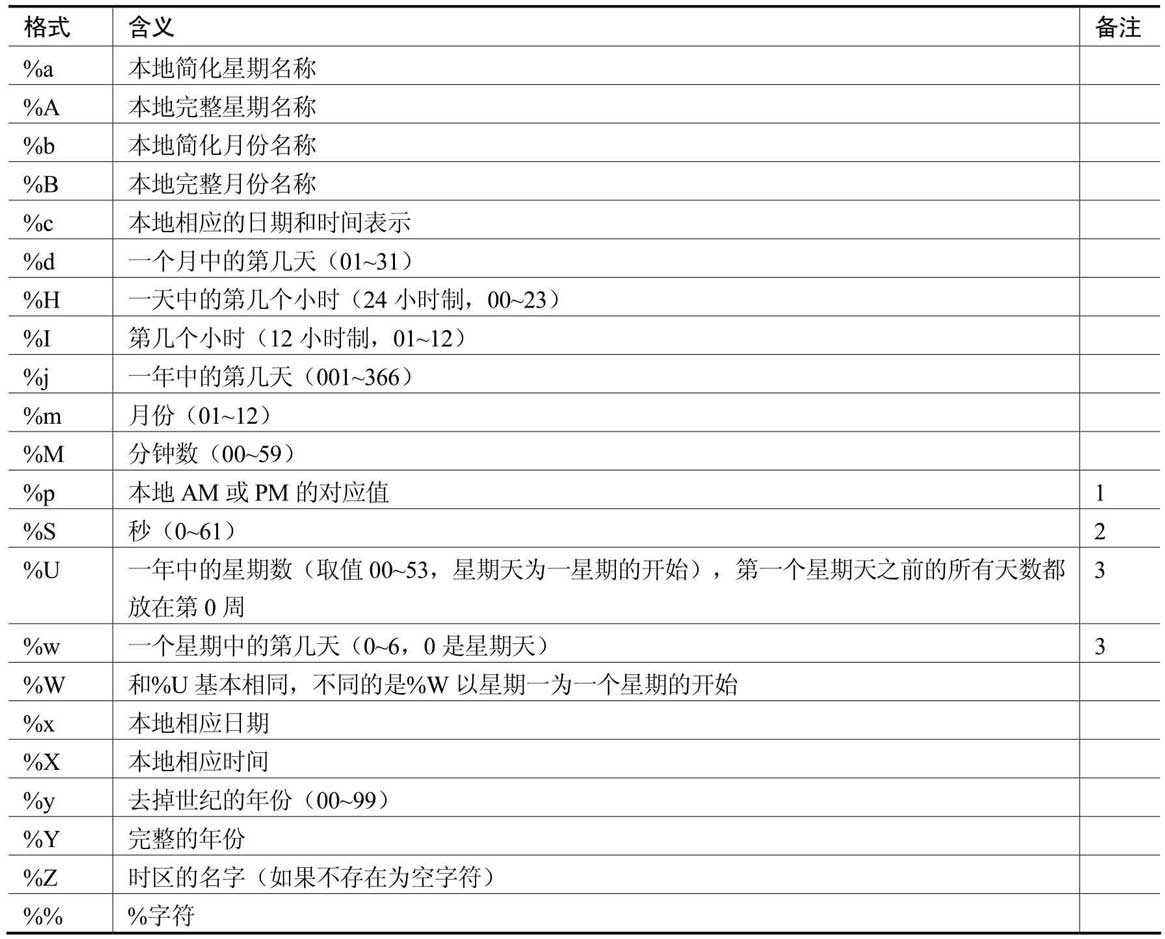Python-日期时间操作
原文地址:https://www.cnblogs.com/-beyond/p/15374829.html
转载请先联系博主!!!
在python中,有内置的time模块和datatime模块来支持时间的一些操作和转换。
time模块
struct_time元组
在python中,有一种叫做struct_time元组的东西来描述时间,将时间细分了,比如:年、月、日、时、分、秒、一年中第几周、一年中第几天、是否为夏令时。

获取struct_time元组的方式,可以使用time模块的localtime()接口,如下面的例子:
import time
print(time.localtime())
输出结果如下:
time.struct_time(
tm_year=2021,
tm_mon=10,
tm_mday=6,
tm_hour=23,
tm_min=47,
tm_sec=52,
tm_wday=2,
tm_yday=279,
tm_isdst=0
)
获取秒级时间戳
直接调用time模块的time()接口就可以获取秒级时间戳,不过需要注意的是:
- 获取的结果是一个
float的浮点数,而并不是正数 - 不同版本
python的执行结果,结果浮点数的精度是不一样的
import time
print(time.time())
# 输出秒级时间戳
# 不同版本的python,输出的结果精度是不一样的
# python2 -> 1633534293.33
# python3 -> 1633534364.272089
获取纳秒级别时间戳
python3中,time模块提供了time_ns()接口来获取当前时间的时间戳(纳秒级别)
import time
timestamp_ns = time.time_ns()
print("timestamp_ns:%s" % timestamp_ns)
# timestamp_ns:1633536722569083000
时间戳转换为struct_time元组
假设现在从接口获取到了时间戳的数据,需要转换为struct_time元组进行操作,那么仍旧可以使用time模块的localtime(),传入时间戳即可,示例如下:
import time
# 获取时间戳
timestamp = time.time()
print("timestamp:%s" % timestamp)
# timestamp:1633535670.74
# 调用localtime()传入时间戳,会将其转换为struct_time元组
struct_time = time.localtime(timestamp)
print("struct_time:%s" % struct_time)
"""
struct_time:time.struct_time(
tm_year=2021,
tm_mon=10,
tm_mday=6,
tm_hour=23,
tm_min=54,
tm_sec=30,
tm_wday=2,
tm_yday=279,
tm_isdst=0
)
"""
struct_time元组转换为时间戳
可以使用time模块的mktime()接口,接收的参数就是struct_time元组形式的数据,直接使用上一步的测试数据吧,示例如下:
import time
struct_time = (2021, 10, 6, 23, 54, 30, 2, 279, 0)
timestamp = time.mktime(struct_time)
print("timestamp:%s" % timestamp)
# timestamp:1633535670.0
从上面的结果可以看到,转换后的时间戳也是一个浮点型,只不过转换后的时间戳和之前的时间戳有点误差,之前的结果是1633535670.74,现在转换回来的是1633535670.0。
ctime-稍微带点可读性的时间格式
上面的时间戳或者struct_time元组,可读性都不是很高,time模块有ctime()接口,可以获取一个可读性比较好的时间格式,为了方便记忆,我把这种格式叫做ctime格式
示例如下:
import time
print(time.ctime())
# Thu Oct 7 00:07:25 2021
time.ctime()接口还可以将时间戳转换为上面的那种格式,需要注意这里指的是秒级时间戳,示例如下:
import time
timestamp = time.time()
print("timestamp:%s" % timestamp)
# timestamp:1633536547.53
format_time = time.ctime(timestamp)
print("format_time:%s" % format_time)
# format_time:Thu Oct 7 00:09:07 2021
将struct_time元组转换为ctime形式
可以使用time模块的asctime()来将struct_time元组的时间转换为ctime形式
import time
struct_time = time.localtime()
print("struct_time:%s" % struct_time)
"""
struct_time:time.struct_time(
tm_year=2021,
tm_mon=10,
tm_mday=7,
tm_hour=0,
tm_min=21,
tm_sec=41,
tm_wday=3,
tm_yday=280,
tm_isdst=0
)
"""
ctime = time.asctime(struct_time)
print("ctime:%s" % ctime)
# ctime:Thu Oct 7 00:21:41 2021
日期时间格式化
前面的时间戳、struct_time、ctime其实可读性都不太好,如果能有2021-10-08 10:30:11这种比较符合人类习惯的就好了。
当然了,python的time模块提供了strftime()接口来实现日期时间格式化的功能,在格式化之前,需要先看一下一些格式的规则:

下面是使用的示例:
import time
struct_time = time.localtime()
format_time = time.strftime("%Y-%m-%d %H:%M:%S", struct_time)
print("format_time: %s" % format_time)
# format_time: 2021-10-07 00:30:20
日期时间的解析
前面讲了可以使用strftime()来将struct_time元组格式化为自定义的形式,但是现在要将自定义形式的日期时间解析为struct_time元组,此时就要用到strptime()接口了,使用示例如下:
import time
format_time = "2021-10-07 00:30:20"
# 传入时间日期,然后指定时间日期的格式,python会按照这个格式去解析
struct_time = time.strptime(format_time, "%Y-%m-%d %H:%M:%S")
print("struct_time: %s" % struct_time)
"""
struct_time: time.struct_time(
tm_year=2021,
tm_mon=10,
tm_mday=7,
tm_hour=0,
tm_min=30,
tm_sec=20,
tm_wday=3,
tm_yday=280,
tm_isdst=-1
)
"""
自定义格式日期转换为时间戳
其实只需要将前面的接口组合一下就可以了,先使用strptime()按照指定格式解析日期,获取到struct_time元组后,使用mktime()即可将struct_time转换为时间戳,示例如下:
import time
format_time = "2021-10-07 00:30:20"
# 传入时间日期,然后指定时间日期的格式,python会按照这个格式去解析
struct_time = time.strptime(format_time, "%Y-%m-%d %H:%M:%S")
# 使用mktime()将struct_time转换为时间卓
timestamp = time.mktime(struct_time)
print("timestamp:%s" % timestamp)
# timestamp:1633537820.0
程序休眠一段时间
每个编程语言都有一个休眠函数,用来让当前的线程或者进程暂停运行(阻塞)一段时间,python的time模块提供了sleep()接口,使用示例如下:
import time
print(time.time()) # 1633538882.96
# 休眠5秒
time.sleep(5)
print(time.time()) # 1633538887.96
# 休眠0.5秒
time.sleep(0.5)
print(time.time()) # 1633538888.47
datatime模块
datetime从名字上就能看出,是date和time两个的组合。
datetime模块有5个类很重要,分别是date、time、datetime、timedelta、tzinfo,使用的比较多的就是datetime了。
获取当前日期时间
直接调用datetime类的now()方法即可获取可读性比较高的日期时间,示例如下:
# 从datetime模块导入datetime类
from datetime import datetime
print("datatime.new(): %s" % datetime.now())
# datatime.new(): 2021-10-07 00:55:24.152208
时间戳与datetime转换
- 提供了
fromtimestamp()接口,传入时间戳即可将其转换为datetime; - 提供了
timestamp()接口,将传入的datetime转换为时间戳;
示例如下:
# 从datetime模块导入datetime类
from datetime import datetime
import time
timestamp = time.time()
print("timestamp:%s" % timestamp)
# timestamp:1633539692.97
dt = datetime.fromtimestamp(timestamp)
print("datetime:%s" % dt)
# datetime:2021-10-07 01:01:32.968801
print("timestamp:%s" % datetime.timestamp(dt))
# timestamp:1633539777.946019
指定格式日期时间与datetime的转换
比如有个日期时间格式:2021-10-08 10:20:30,要转换为datetime,怎么搞?使用strptime
或者说有个datetime,要转换为2021-10-08 10:20:30形式,后面不需要小数点的形式?使用strftime()接口
# 从datetime模块导入datetime类
from datetime import datetime
format_time = "2021-10-08 10:20:30"
dt = datetime.strptime(format_time, "%Y-%m-%d %H:%M:%S")
print("datetime:%s" % dt)
# datetime:2021-10-08 10:20:30
dt_now = datetime.now()
format_time = datetime.strftime(dt_now, "%Y-%m-%d %H:%M:%S")
print("format_time:%s" % format_time)
# format_time:2021-10-07 01:14:10
原文地址:https://www.cnblogs.com/-beyond/p/15374829.html
转载请先联系博主!!!

